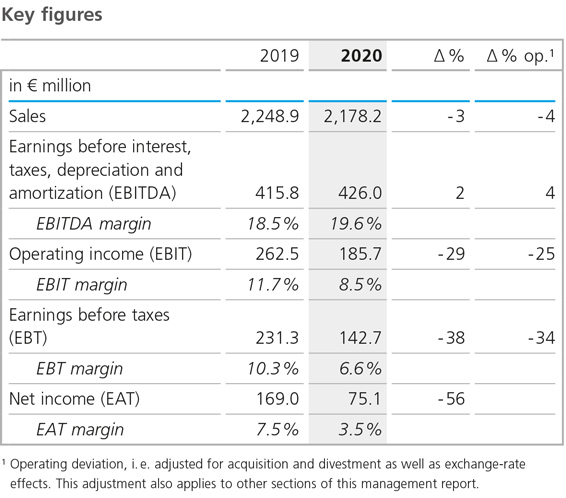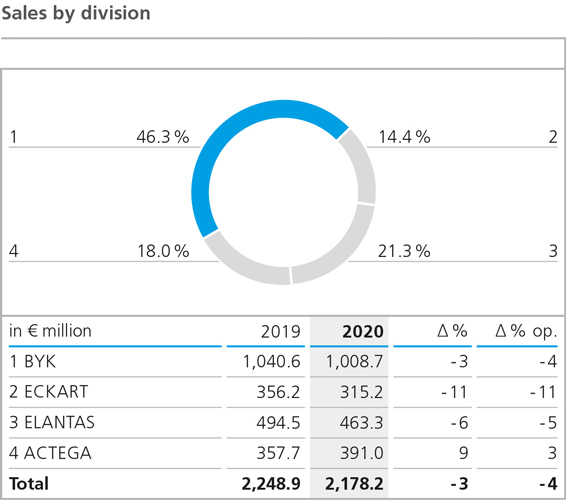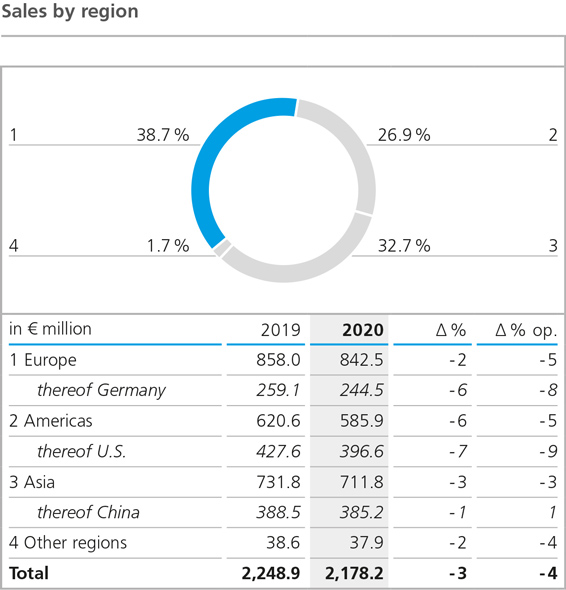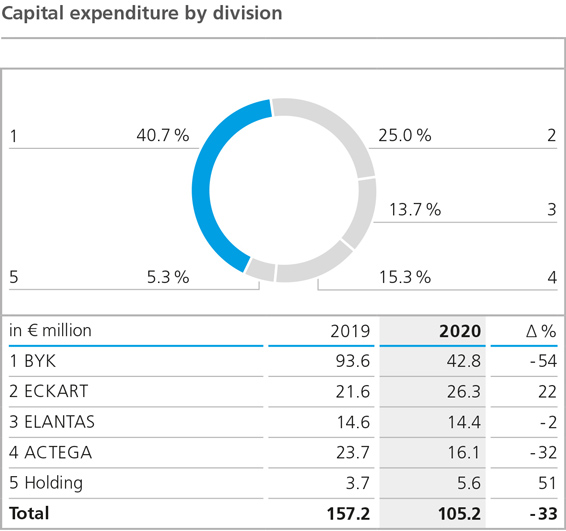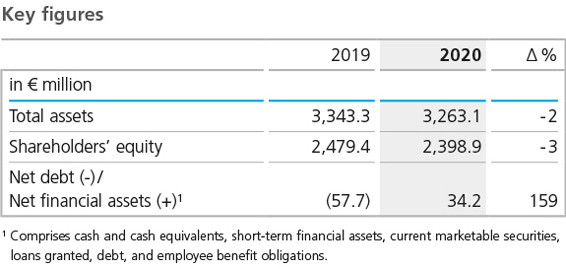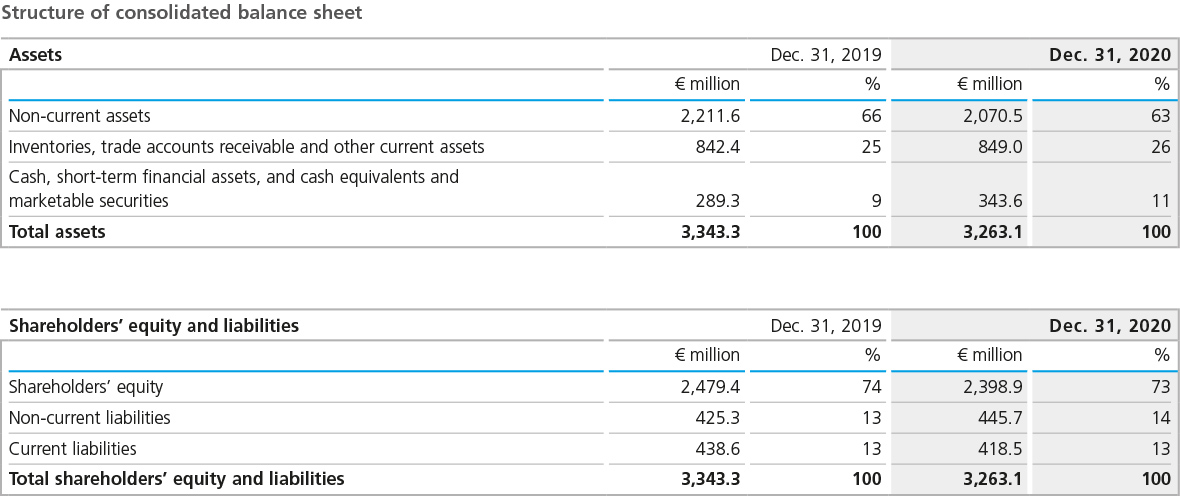Letter from the Management Board | About This Report | Sustainability Management | Corporate Bodies and Management | Report of the Supervisory Board | ALTANA in Everyday Life | Group Management Report | Products | Safety and Health | Environment | Human Resources | Social Commitment | Consolidated Financial Statements (condensed version) | Multi-Year Overview | Global Compact: Communication on Progress (COP) | ALTANA worldwide | List of Full Ownership | Overview - About This Report | Contact
General Business Setting
Overall Economic Situation
2020 was primarily marked by the course and effects of the coronavirus pandemic. The International Monetary Fund (IMF) currently estimates that global economic output declined by -3.5 %. The recession that began in China at the beginning of 2020 and then spread to the entire world in the course of the second quarter led, in some cases, to double-digit negative growth rates in the middle of the year. However, early containment of the pandemic in China and resumption of industrial production in other regions in the second half of the year enabled 2020 as a whole to be better than had been projected by the IMF in its mid-year forecast. In addition to the pandemic, the continuing tense trade situation between the U.S. and China and the situation regarding the terms of the United Kingdom’s exit from the European Union, which remained unclear until shortly before year’s end, also had an adverse effect on the overall economic situation. Only China was able to record modest growth for the year as a whole. For every other major economy, the situation described above gave rise to a more or less pronounced recession last year.
At -7.2 %, as expected by the IMF, the Eurozone was hit particularly hard by the pandemic-related curtailment of economic activity, which intensified the slackening demand that had already begun in the previous year. Government measures and overarching support measures in the area of employment protection, as well as further public transfer payments, ensured a certain degree of stability in many countries. Nevertheless, all of the major economies in Europe reported a significant weakening of gross value added. In Germany, the IMF estimates that economic output fell by 5.4 %, although there was a marked recovery in industrial production at the end of the year.
According to current IMF estimates, economic development in the countries of the Americas was also negative in 2020, albeit with significant gradations. While the U.S. reported a decline in gross value added of only 3.4%, in Canada GVA fell by 5.5 % and in the Latin American countries by 7.4 % overall. There were also clear differences in Latin America. Brazil, for example, surpassed the expectations for the rest of the continent, with the IMF anticipating a decrease of 4.5 %.
Asia was a mixed bag in 2020. While China fully recovered from its economic slump at the beginning of the year due to its early containment of the pandemic, finishing the year with a growth rate of 2.3 %, gross value added in India fell by 8.0 %. According to the IMF, the largest economies in Southeast Asia (ASEAN-5) recorded economic output of -3.7 % in 2020, whereas the figure in Japan was -5.1 %.
Industry-Specific Framework Conditions
The American Chemistry Council (ACC) estimates that global chemical production was -2.6 % in the past fiscal year (previous year: +1.2 %). As a result, the global impact of the pandemic on chemical production was somewhat lower than from a macroeconomic perspective.
The changes in chemical production do not reflect the regional development of general economic performance in all countries. According to the ACC, Germany, Europe’s largest chemical producer, achieved a slight increase of 0.1 % for the industry as a whole. However, excluding the share of the pharmaceutical sector, a low single-digit decline is expected for the past fiscal year (German Chemical Industry Association (VCI): -1.1 %). By contrast, other European countries of importance to the chemical industry, including France (-11.9 %) and Italy (-6.2 %), displayed much higher decreases in overall industry production output, according to ACC estimates. In the United Kingdom, the industry remained roughly at the previous year’s level (0.4 %). In Europe as a whole, chemical production decreased by 2.2 %.
In the U.S., overall chemical production fell by 3.6 %, with production in the medical, hygiene products, and DIY sectors outperforming other areas of the industry. The crisis hit Latin America harder, leading to a 7.2 % decline in production volumes. At an expected -5.8 %, the decrease in Brazil was less pronounced than in Latin America as a whole.
The chemical sector in the Asia-Pacific region recorded the smallest decline in the 2020 fiscal year, at -2.1 %. In keeping with the overall economic development, China, the largest producer with 0.3 % growth, was largely responsible for this development. The crisis had a stronger impact in India, however, with production down by 6.1 %. Other Asian countries, such as Korea (-5.9 %) and Japan (-9.7 %), also experienced a sharp decline due to the pandemic.
On account of government measures to contain the pandemic, the associated closure of many production companies, and the subsequent slowdown in demand, the price of a barrel of Brent crude oil fell from an initial 67 U.S. dollars to a historic low of 18 U.S. dollars from January to April 2020. The restart of production and rising demand caused the price to rise steadily again over the course of the summer, stabilizing at a level of 50 U.S. dollars at the end of the year. The average price for the year was 42 U.S. dollars, well below the previous year’s level (64 U.S. dollars).
Important Events for Business Development
In 2020, non-operating effects at ALTANA influenced the company’s earnings and financial position as well as its assets.
In January 2020, ALTANA acquired the business with innovative additives for exploration of the U.S. company Gulf Scientific Inc. as part of an asset deal. The activities were integrated into the BYK division and had a slightly positive impact on sales development. The Swiss company Schmid Rhyner AG, acquired in February 2020, with activities in the field of overprint varnishes for the packaging and printing industries, was taken over by the ACTEGA division. Schmid Rhyner AG made a positive contribution to sales and had a slightly negative share in earnings. Furthermore, in May 2020, ALTANA acquired the British company Aluminium Materials Technologies Ltd. The firm, which develops and sells special alloys for 3D printing, was integrated into the ECKART division, in which it contributed a minor share to sales performance in 2020.
In 2020, the development of the exchange rates between the euro, the Group currency, and other currencies important for ALTANA, had a negative influence on the sales and earnings development. The exchange rate of the euro to the Brazilian real had the biggest effect in 2020. At an average of 5.89 real for one euro, it was higher than in the previous year (4.41 real for one euro). Further significant effects from changed exchange-rate relations resulted from the rate of the U.S. dollar to the euro, which at 1.14 U.S. dollars for one euro was also higher than in the previous year (1.12 U.S. dollars for one euro). The average exchange rate of the euro against the Chinese renminbi also increased, from 7.74 renminbi to 7.87 renminbi for one euro. The effects of the translation of the financial statements of the major non-euro Group companies on items of the 2020 income statement were negative overall. Differences in exchange rates on the balance sheet date also had a significantly negative influence on balance sheet items compared to the previous year.
Group sales totaled € 2,178.2 million in 2020, a decrease of 3 % or € 70.8 million compared to the previous year (€ 2,248.9 million). Non-operating effects generally had a positive effect on the sales development. Exchange-rate changes, primarily from the changed relations of the euro to the Brazilian real and the U.S. dollar, resulted in a sales decrease of about 2 %. Acquisitions, on the other hand, increased sales by a total of € 54.2 million. The effects were calculated in each case on the basis of the months to which the acquired business belonged to the Group. Of this amount, € 33.0 million were attributable to the acquisition of Schmid Rhyner AG in Switzerland (ACTEGA division) in the spring of 2020, a total of € 17.8 million to the acquisitions of the businesses of Gulf Scientific and Paul N. Gardner, both in the U.S., in the BYK division, and € 3 million to the acquisition of the Hubergroup wire enamels business in India (ELANTAS division). The British company Aluminium Materials Technologies Ltd., acquired by the ECKART division in May 2020, increased Group sales by € 0.4 million. Adjusted for currency and acquisition effects, sales were 4 % below the previous year.
This means that we did not achieve the operating sales growth in low single-digit percentages forecast at the beginning of the year for 2020. However, in view of the challenging economic situation caused by the pandemic, an operating sales decline of only 4 % reflects the Group’s competitiveness. In the different quarters of 2020, strong volatility in business activity was observed. After a very good start in the first quarter of 2020 – caused in part by stockpiling on the part of our customers – the measures introduced worldwide from March to contain the pandemic led to a downturn in sales in large parts of the manufacturing sector in the second quarter. From the middle of the year there was a recovery – first in China, then in the other regions – resulting in an unexpectedly strong fourth quarter to finish the year. There were many product segments, particularly in the automotive sector, for which demand was significantly lower due to the pandemic. At the same time, other consumer-related applications, such as food packaging solutions, became more important. The changes in this area were due to both demand-related fluctuations in sales volumes and price/mix effects, which affected all divisions, albeit to varying degrees.
The regional sales and sales structure shifted only slightly compared to the previous year. With an unchanged share of 39 % of total Group sales, Europe remains the most important sales region for ALTANA. Due to acquisitions, nominal sales in Europe were 2 % below the previous year’s figure, but 5 % lower in operating terms. The pandemic led to declining sales in the entire Eurozone and the United Kingdom. Only in Turkey and some Eastern European countries was the sales volume higher than in the previous year.
In 2020, sales in the Americas were 6 % down on the previous year. Adjusted for negative exchange-rate effects and lower positive acquisition effects, operating sales dropped by 5 %. Sales in the U.S. – still ALTANA’s largest single sales market, accounting for 18 % of total sales – fell by 9 % in operating terms. The sales decline in the U.S., as in all other regions, was primarily pandemic‑related. Demand for the BYK division’s specialty products in the exploration sector remained low, due to the low crude oil price level. Canada recorded a slight increase in sales. In Brazil, operating sales grew significantly in a year-to-year comparison, while sales decreased in other Latin American countries. Overall, the Americas’ share of Group sales decreased slightly (27 %; previous year: 28 %). Asia continued to account for 33 % of Group sales in the past fiscal year. In both nominal and operational terms, Asia recorded the smallest sales decline last year, at 3 % in each case. This was primarily due to the swift and sustained recovery in Chinese business activities, which were even able to contribute operating growth of 1 % at the end of the year. China continues to be ALTANA’s second largest sales market, accounting for around 18 % of total sales (previous year: 17 %). India, however, our second largest Asian sales market, suffered pandemic‑related operating sales losses of 10 %.
Sales Performance of BYK
In the 2020 fiscal year, sales in the BYK division fell by 3 % or € 31.9 million to € 1,008.7 million (previous year: € 1,040.6 million). This includes negative exchange-rate changes of € -9.8 million as well as positive effects of € 17.8 million due to the acquisition of the business activities of Gulf Scientific and Paul N. Gardner in the U.S. Adjusted for these effects, operating sales were 4 % lower than in the previous year.
The BYK division’s sales performance in 2020 was influenced by the pandemic in almost all markets and regions. In addition to the effects of the difficult overall economic environment already experienced in the previous year, caused in particular by weak demand in the automotive industry and the exploration sector, the measures implemented to contain the pandemic in the second quarter led to a sales decline across all areas. Starting in the middle of the year, sales especially of paint and coating additives recovered, partly due to strong demand in the DIY sector. At the end of the year, overall product sales developed disproportionately compared to the same period of the previous year. This was primarily the case with additives sales, which for the year as a whole were only 3 % lower than the previous year’s level in operational terms. The division’s measuring and testing instruments business suffered from continued weak demand in the automotive industry, recording a 14 % decline in nominal sales.
The operating sales decreases across the entire division showed regional differences. Although sales in Asia were down slightly in operating terms, they were positively impacted by a significant increase in operating sales in China, BYK’s second largest single market. Other countries in Asia, including India, reported double-digit operating sales declines. Operating sales in the Americas – mainly influenced by the U.S., BYK’s largest single market – also fell vis-à-vis the previous year. While the negative development of the prior year continued in the United States, exacerbated by the pandemic, Brazil, Mexico, and Canada were able to increase operating sales compared to the previous year. The Europe region, particularly the Eurozone, also reported a sales decrease. The significant decline, particularly in Italy, France, and Germany, could not be offset by the operating growth in individual Eastern European markets.
Sales Performance of ECKART
In 2020, the ECKART division achieved sales of € 315.2 million (previous year: € 356.2 million). The 11 % decline in year-to-year terms was negatively impacted by exchange-rate effects and positively influenced to a small degree by the acquisition of UK-based Aluminium Materials Technologies Ltd. in the middle of the year. Adjusted for these effects, operating sales decreased by 11 %. Sales were negatively impacted above all by the pandemic-related decline in demand in the automotive and cosmetics industries, as well as other sectors. The discontinuation of a trading business in China in mid-2019 also had a diminishing effect on the year-on-year growth rate.
The difficult market environment was reflected in all regions in 2020, albeit to varying degrees. While Asia recorded only a slight decline in operating sales development, sales in the Americas region were significantly lower than in 2019. The pandemic also had a negative effect on sales in Europe, especially in the Eurozone. The positive development of some Eastern European countries was unable to compensate for this.
Sales Performance of ELANTAS
In the ELANTAS division, sales fell by 6 % or € 31.2 million to € 463.3 million in 2020 (previous year: € 494.5 million). Adjusted for negative currency effects and positive acquisition effects, the operating sales decline amounted to 5 %. The main driver was the global impact of the pandemic on demand, which was reflected in all of ELANTAS’ major business areas in 2020.
The regional impact of the pandemic on sales development was mixed. In Asia, particularly China, the division’s largest sales market, almost compensated for the initial sales slump by the end of the year. But India and other countries in Asia were unable to do so and closed the year with significant sales losses. The Americas, with the U.S. as the largest individual market, also recorded a sales drop, with negative exchange-rate effects exacerbating the situation. In this region, Brazil developed positively, reporting sales well above the previous year’s level. In Europe, too, sales declined as a result of the pandemic, due in particular to weak demand in Germany, France, and Italy.
Sales Performance of ACTEGA
With sales of € 391.0 million (previous year: € 357.7 million), the ACTEGA division posted substantial nominal growth of 9 % compared to 2019. Even adjusted for the effect of the acquisition of the Swiss company Schmid Rhyner AG and for negative exchange-rate effects, ACTEGA achieved operating growth of 3 %, significantly above the previous year’s level. The growth resulted both from a slight increase in sales volumes and from positive effects from the product mix and price levels.
Since 2020, ACTEGA has reported its sales in three business lines: Paper & Board, Flexible Packaging, and Metal Packaging Solutions. There were positive developments in all three business lines. The Paper & Board line was able to increase its sales primarily due to the acquisition of the Swiss company Schmid Rhyner AG. In operational terms, however, sales declined. This was mainly due to the business with products for magazines and print inserts as well as highquality folding carton packaging. In contrast, sales of functional products for food packaging increased over the previous year as a result of changed consumer behavior due to the pandemic. The division’s flexible packaging business also closed 2020 on a positive note. The Metal Packaging Solutions business line additionally boosted sales, with the business with PVC-free sealants and inks for beverage cans posting the most growth.
The regional sales structure of the ACTEGA division shifted slightly in favor of the Europe region in 2020 due to the acquisition of Swiss Schmid Rhyner AG (2020: 51 %; previous year: 48 %). The development in the different regions was uneven. In Europe, the division’s largest region, sales exceeded the previous year’s level. A decline in operating sales in Germany was more than offset by increases in other European countries. In the Americas, nominal sales lagged behind the previous year. Adjusted for negative exchangerate effects, however, operating sales were higher than in 2019. In the U.S., ACTEGA’s largest single market, operating sales were slightly down on the previous year. By contrast, sales in Brazil increased significantly in local currency terms. Only in Asia did the division not increase its sales in 2020. In this region, nominal and operating sales were lower than in the previous year.
Earnings Situation
Despite the difficult overall economic situation and the related decline in operating sales, ALTANA’s earnings situation in 2020 was better than in the previous year. Earnings before interest, taxes, depreciation and amortization (EBITDA) rose year-over-year by 2 % or € 10.2 million to € 426.0 million (previous year: € 415.8 million). Adjusted for acquisition and exchange-rate effects, operating growth amounted to 4 %. At 19.6 %, the EBITDA margin was significantly higher than in the previous year (18.5 %) and thus in the upper edge of our strategic target range of 18 % to 20 %. This was achieved partly through cost containment measures in view of the significant slowdown in demand in some months. On the other hand, pandemic-related one-time effects led to savings in functional cost areas. In addition, a materials cost ratio significantly lower than was forecast due to lower raw material costs contributed to the result.
As a result of the aforementioned savings effects, EBITDA exceeded our expectations for 2020. Aside from the cost effects, the increase in the EBITDA margin is also due to the pandemic-related sales decline.
The most important cost parameter for ALTANA, variable raw-material and packaging costs, developed positively compared to the prior year. The material usage ratio, the ratio of these costs to sales, fell to 41.3 % in 2020 (previous year: 42.7 %). All four divisions benefited from this trend, albeit to varying degrees.
Among the other main cost items, particular mention should be made of personnel expenses and depreciation and amortization, which showed significant one-time effects in the past fiscal year. Overall, personnel expenses remained at the previous year’s level despite increases in collective bargaining costs. This was due to temporary short-time working measures in the months when we experienced a slump in demand. In addition, there was only very limited recruitment and backfilling of vacancies. The ratio of total personnel costs to sales increased to 23.4 % (previous year: 22.7 %) on account of the sales decline. However, the consequences of the pandemic were also reflected in other cost types: Travel and trade fair costs in particular showed a significant decrease compared to the previous year, leading to cost reductions across all functional areas. As part of the impairment tests for the ECKART division, an impairment loss of € 85.6 million was identified for the total goodwill in 2020, which was recorded in other operating expenses. The impairment resulted from an assessment of future business development that also included various planning scenarios with probabilities of occurrence due to the overall economic uncertainty. Compared to our other divisions, ECKART’s sales and earnings performance was more strongly affected by flagging demand resulting from the coronavirus pandemic, particularly since the share of business with automotive and cosmetics customers in the division’s total sales is significantly higher. Derived from this, the weighted scenario-based valuation results in a weaker estimate than in previous years. Adjusted for this impairment effect, depreciation and amortization was 1 % higher than in the previous year, due to high investments in property, plant and equipment in previous years.
In all other functional cost areas, absolute cost reductions were recorded in the past fiscal year. Within production costs, personnel costs in particular were below the prioryear level due to measures taken in connection with short‑time working due to the decline in demand. In addition, lower travel costs led to savings. Only depreciation and amortization showed a significant year-on-year increase due to recent investments.
Selling and distribution expenses fell by 2 % in 2020 compared to the previous year. However, the relative ratio to sales increased slightly due to the sales drop. The decrease in selling and distribution expenses was driven in particular by lower travel and trade fair costs, whereas personnel expenses and depreciation and amortization rose.
For the first time in many years, research and development costs did not increase in fiscal 2020. Although personnel expenses in this area rose slightly and depreciation and amortization were higher than in the previous year, a decrease in travel expenses led to an overall reduction in costs. However, the ratio of research and development costs to sales increased slightly from 7.4 % to 7.5 % due to the sales decline.
In 2020, administrative expenses were lower than in 2019. Personnel cost increases were completely offset by savings on travel and consulting costs. In contrast, the ratio of administrative expenses to sales shows a slight increase from 4.7 % to 4.8 %, which is also attributable to the decrease in sales.
The balance of other operating income and expenses was significantly influenced by the amortization of goodwill at ECKART. This expense item was also impacted by one‑time special charges in the area of trade accounts receivable due to a risk provision for possible bad debts as a result of any pandemic-related insolvencies. Earnings before interest and taxes (EBIT) amounted to € 185.7 million, 25 % lower in operational terms than in the previous year (€ 262.5 million).
At € -4.2 million, the financial result was significantly lower than the previous year’s figure of € 7.9 million. This decline was due in particular to one-time effects included in 2019, such as interest income from tax mutual agreement procedures, changes in the value of investments, and an outstanding earn-out obligation from an acquisition. The result of companies accounted for using the at-equity method changed only slightly, from € -39.1 million in the previous year to € -38.9 million in the 2020 fiscal year. The largest share of this loss resulted from the investment in Landa Corporation Ltd.
Earnings before taxes (EBT) fell to € 142.7 million (previous year: € 231.3 million), and earnings after taxes (EAT) to € 75.1 million (previous year: € 169.0 million). Income taxes were higher than in the previous year due to the significantly lower one-time effects from tax agreement proceedings.
In the past fiscal year, ALTANA invested a total of € 105.2 million in intangible assets and property, plant and equipment. As a consequence, capital expenditure was significantly below the prior-year figure (€ 157.2 million). The investment ratio, that is the ratio of investments to sales, was slightly below our long-term target range of 5 % to 6 %, at 4.8 %. Due to the uncertainties surrounding the pandemic-related business development, investments were focused on the strategically and operationally most important projects.
A total of € 96.3 million (previous year: € 146.9 million) was invested in property, plant and equipment. For several years, major projects have been carried out to strategically expand production and laboratory capacities. Investments in intangible assets reached € 8.9 million in the past fiscal year, compared to € 10.3 million in 2019.
In the regional distribution of investments, there was a shift in favor of Europe vis-à-vis the previous year. While the America’s share decreased from 40 % in 2019 to 31 %, Europe’s share grew to 57 % (2019: 49 %). The main focus of investment activity was on Germany (44 %) and the U.S. (29%). Asia’s share of the total volume remained virtually unchanged at 12 % (2019: 11 %).
The BYK division invested a total of € 42.8 million in 2020, significantly less than in the previous year (€ 93.6 million). Investment activity concentrated on the further expansion of production capacities in the U.S. and on a site in China. Other investments concerned research and development capacities as well as strategic digitization projects.
At € 26.3 million, the ECKART division’s investment volume was higher than in the previous year (€ 21.6 million). As in 2019, the division’s site in Güntersthal and a site in the U.S. accounted for by far the largest shares.
The ELANTAS division invested € 14.4 million in property, plant and equipment and intangible assets, almost the same amount as in the previous year (€ 14.6 million). In the past fiscal year, the division invested primarily in the production facilities of its European companies.
At € 16.1 million, the ACTEGA division’s capital expenditure was at a lower level than in 2019 (€ 23.7 million). Investments in the past financial year mainly related to the expansion of manufacturing capacities at German sites.
Balance Sheet Structure
In the course of the 2020 fiscal year, the ALTANA Group’s total assets decreased from € 3,343.3 million to € 3,263.1 million. The decline of € 80.2 million or -2 % is mainly due to an amortization of intangible assets (amortization of goodwill at ECKART) and the valuation of at-equity investments. Overall, exchange-rate effects led to a significant devaluation of the balance sheet items of the companies managed in foreign currencies.
Intangible assets fell to € 933.1 million (previous year: € 1,023.9 million). This reflects the amortization of goodwill in the ECKART division. Property, plant and equipment also dropped in value, developing from € 970.8 million in the previous year to € 959.5 million. With additions of € 96.3 million, the level of investment in property, plant and equipment was slightly below that of depreciation and amortization. Exchange-rate effects led to a decrease in the carrying amounts in the Group currency, the euro.
Total non-current assets amounted to € 2,070.5 million as of the reporting date (previous year: € 2,211.6 million), down €141.2 million on the previous year. Their share of total assets decreased to 63 % (2019: 66 %).
The change in current assets was mainly due to the increase in cash and cash equivalents. Net working capital was not subject to any major changes in absolute terms compared to the previous year. Inventories remained at a low level of € 336.4 million (previous year: € 348.8 million), partly due to inventory-optimizing measures and partly due to high demand at the end of the year. At € 400.5 million, trade accounts receivable were slightly higher than in the previous year (2019: € 380.6 million). This also reflects the high level of sales at the end of the year. In the balance with current liabilities, net working capital was slightly above the 2019 level (€ 547.0 million) at € 550.3 million. The scope of net working capital, in relation to the business development of the previous three months, decreased to 101 days, compared to 108 days at the end of 2019. Absolute net working capital thus developed in line with our expectations, but the scope was much more positive due to the good performance at the end of the year. At the beginning of the year, we had forecast a change in absolute net working capital in keeping with the general business trend and only a slight improvement in scope. In the course of the year, cash and cash equivalents increased to € 313.7 million (previous year: € 264.6 million). Total current assets climbed to € 1,192.6 million (previous year: € 1,131.7 million).
On the liabilities side, changes arose primarily due to exchange-rate-related reductions in equity. Group equity decreased by € 80.5 million or -3 % to € 2,398.9 million (previous year: € 2,479.4 million). This decline is largely attributable to negative effects from exchange-rate fluctuations. The positive result for 2020 had a counteracting effect. At 73 %, the equity ratio on December 31, 2020 was roughly on a par with the previous year (previous year: 74 %).
The total non-current liabilities were further increased by the expansion of pension provisions due to the further decline in the actuarial interest rate used to discount the corresponding obligations. On the other hand, the deferred taxes reported on the liabilities side decreased. In total, non-current liabilities rose by € 20.4 million to € 445.7 million (previous year: € 425.3 million).
The total current liabilities reported on the balance sheet as of December 31, 2020, decreased from € 438.6 million to € 418.5 million. The financial liabilities from promissory note loans of € 48 million still reported at the end of 2019 were repaid in full during 2020. Trade accounts payable increased slightly by € 4.1 million in 2020.
The balance of cash and cash equivalents, short-term financial assets, current marketable securities, loans granted, financial liabilities, and employee benefit obligations resulted in net financial assets of € 34.2 million at the balance sheet date of December 31, 2020, after net debt of € 57.7 million at the end of 2019.
Principles and Goals of Our Financing Strategy
We generally aim to finance our operating business activities from the cash flow from operating activities. The same applies to the need for capital expenditure, which caters to the continual expansion of business activities.
As a result, our financing strategy is oriented to keeping the cash and cash equivalents generated within the Group centralized. In addition, a financing framework is sought that enables ALTANA to flexibly and quickly carry out acquisitions and even large investment projects beyond the accustomed scope.
To successfully implement these goals, we manage nearly all of the Group’s internal financing centrally via ALTANA AG. To this end, cash pools are set up for the important currency areas.
There were no more liabilities from the issue of promissory note loans at the end of 2020. The last outstanding repayment totaling € 48.0 million was made in November 2020. There is a general syndicated credit facility of € 250.0 million. The term of this credit facility will last until 2022 and had not been utilized on the balance sheet date.
This financing structure offers ALTANA the flexibility it needs to appropriately take advantage of short-term or investment-intensive growth opportunities. The distribution of the maturities of the financing instruments we use enables us to optimally control repayment of liabilities with inflows from operating cash flow.
Off-balance-sheet financing instruments result from purchasing commitments and guarantees for pension plans. Details on the existing financing instruments are provided in the complete Consolidated Financial Statements.
In the course of 2020, cash and cash equivalents increased by € 49.1 million to € 313.7 million (previous year: € 264.6 million). At € 373.6 million, the cash inflow from operating activities was only slightly below the previous year’s level (€ 386.3 million), despite the lower Group net income. This is primarily due to a high proportion of non-cash portions of the previous year’s earnings, particularly as a result of the goodwill impairment in the ECKART division.
Cash flow from investment activities decreased slightly to € 220.0 million (previous year: € 228.8 million). Although expenditure for acquisitions, resulting mainly from the purchase of Schmid Rhyner AG in Switzerland and Gulf Scientific in the U.S., was at a much higher level than in 2019, investments in intangible assets and property, plant and equipment were lower.
Cash flow from financing activities amounted to € 99.9 million in the 2020 fiscal year, less than in the previous year (€ 134.6 million). The current debt outflows concerned the scheduled repayment of the aforementioned promissory note tranche totaling € 48.0 million, the assumption of a shareholder loan in connection with the acquisition of Schmid Rhyner AG, and lease payments. In the 2020 fiscal year, ALTANA AG paid a dividend amounting to € 30.0 million (prior year: € 50.0 million).
ALTANA determines the change in the company’s value via the key figure ALTANA Value Added (AVA), whose calculation is explained in the “Group Basics” section. In the 2020 fiscal year, despite the challenging economic situation caused by the pandemic, a positive contribution was made to our company’s value again, which was above the previous year and surpassed our expectations.
The only slight decline in earnings is reflected in the operating earnings, which at € 246.1 million did not quite reach the previous year’s figure (€ 250.1 million). The Group’s average capital employed increased slightly in 2020 to € 2,928.7 million (previous year: € 2,856.6 million). However, the cost of capital decreased from 8.0 % to 7.5 %, representing a reduction of € 219.6 million (previous year: € 228.5 million).
At 8.4%, the return on capital employed (ROCE) did not reach the previous year’s level (8.8 %). Absolute value added totaled € 26.5 million in the past fiscal year, compared to € 21.6 million the year before, and relative AVA rose from 0.8 % to 0.9 % in 2020.
The decline in value management key figures forecast for 2020 was avoided due to the favorable development of the earnings situation.
Overall Assessment of Our Business Performance and Business SituationIn the course of 2020, the macroeconomic framework was massively impacted by the pandemic. This was reflected in the course of the year by strongly fluctuating sales trends and capacity utilization at the production facilities, to which we were able to respond flexibly. A moderate decline in sales coupled with favorable raw-material price developments enabled us to maintain a good earnings level. Additional pandemic-related cost savings and savings achieved through proactive measures resulted in an improved earnings situation compared to the previous year, a margin at the upper edge of our strategic target range and an improved value of the company. Parallel to managing the pandemic, we continued to press ahead with our strategic activities to develop medium- to long-term growth areas and the digital transformation. Our balance sheet continued to show a very solid structure at the end of 2020 and offers sufficient financial headroom for investments in sustainable profitable growth. |

